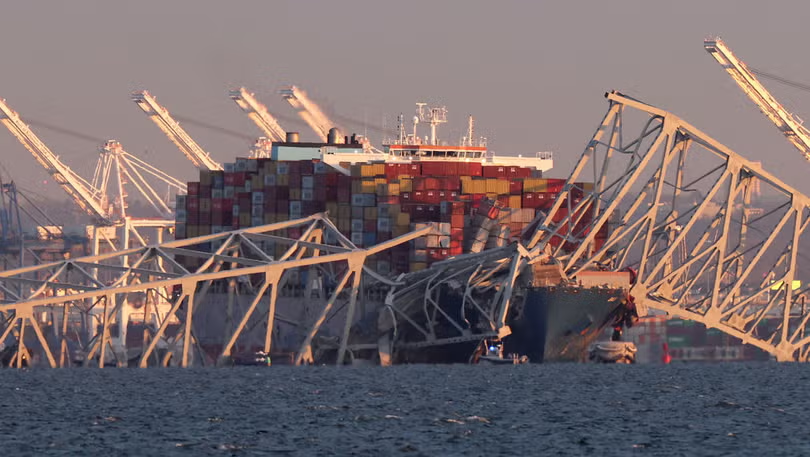The Francis Scott Key Bridge, a vital part of Baltimore’s transportation infrastructure, suffered a catastrophic collapse on March 26, 2024. The event sent shockwaves through the city and the nation, highlighting vulnerabilities in bridge safety and maritime navigation. One year later, we look back at the incident, the investigations that followed, and the efforts to rebuild and prevent future tragedies.
The Importance of the Francis Scott Key Bridge
Built in 1977, the Francis Scott Key Bridge was an essential link in Baltimore’s transportation network. Spanning the Patapsco River, it connected thousands of commuters and commercial vehicles daily. Named after the author of “The Star-Spangled Banner,” the bridge symbolized both history and progress.
Before its collapse, the bridge carried approximately 30,000 vehicles daily, serving as a crucial route for both local and interstate traffic. Its sudden destruction created a logistical and economic crisis, disrupting trade and transportation in the region.
The Tragic Collapse: What Happened?
In the early hours of March 26, 2024, the cargo ship Dali, registered under a Singaporean flag, collided with a crucial support pillar of the Francis Scott Key Bridge. The massive impact led to an immediate collapse of a large section of the bridge into the Patapsco River. The incident resulted in six fatalities, all construction workers who were performing maintenance at the time.
Investigators later confirmed that the ship had experienced a loss of power and steering control just before the collision. Despite a mayday call warning officials of the impending crash, there was not enough time to evacuate all workers from the bridge.
Immediate Aftermath and Emergency Response
Following the collapse, emergency teams quickly launched search and rescue operations. While some individuals were rescued from the water, the tragic loss of six workers underscored the severity of the disaster.
Authorities temporarily closed the Port of Baltimore to assess the damage and recover debris. This closure had significant economic repercussions, as Baltimore is a key hub for shipping and transportation along the East Coast.
Investigation Findings and Bridge Safety Concerns

Over the past year, multiple agencies, including the National Transportation Safety Board (NTSB) and the Federal Highway Administration, have conducted extensive investigations into the collapse. Their findings revealed several key points:
- High-Risk Structure: The Francis Scott Key Bridge was identified as being nearly 30 times more vulnerable to collapse from a ship collision than acceptable safety thresholds.
- Lack of Protective Measures: Unlike some modern bridges, it lacked protective barriers, such as fendering systems, that could have mitigated the impact of the ship collision.
- Neglected Safety Assessments: Maryland transportation officials had not conducted updated risk assessments, despite recommendations dating back to 1991 and 2009.
These revelations raised concerns about the safety of similar bridges across the United States. In response, officials have called for vulnerability assessments on 68 bridges in 19 states, ensuring they are reinforced against maritime accidents.
The Economic and Community Impact
The collapse of the Francis Scott Key Bridge had a widespread impact on both the local economy and national trade. Some of the key consequences included:
- Disruptions to Traffic: With a major transportation link severed, local commuters and businesses faced significant detours and delays.
- Port Closure Costs: The Port of Baltimore’s temporary shutdown delayed shipping operations, affecting industries dependent on imports and exports.
- Job Losses: The economic downturn caused by the incident led to temporary layoffs and financial strain on local businesses.
Beyond economic concerns, the tragedy deeply affected the families of the six victims. Memorial services and community vigils honored their lives, emphasizing the human cost of the disaster.
Government Response and Funding for Reconstruction
In response to the tragedy, President Joe Biden requested nearly $100 billion in emergency disaster aid, allocating funds for bridge reconstruction and infrastructure improvements. The estimated cost for rebuilding the bridge is projected at $2 billion, with a targeted completion date of 2028.
Federal and state officials have prioritized ensuring that the new bridge will be built with modern safety enhancements, including impact-resistant supports and advanced traffic monitoring systems.
Future of Bridge Safety in the U.S.
The Francis Scott Key Bridge collapse has sparked a national conversation about infrastructure resilience. Experts have recommended several measures to enhance bridge safety, including:
- Regular Structural Assessments: Updating risk assessments for bridges in high-traffic maritime zones.
- Improved Barrier Systems: Installing protective barriers to absorb the impact of potential ship collisions.
- Stronger Maritime Regulations: Implementing stricter guidelines for large vessels navigating near bridges.
These measures aim to prevent similar incidents and protect critical infrastructure nationwide.
Conclusion
One year after the collapse of the Francis Scott Key Bridge, the city of Baltimore continues to recover. While the tragedy exposed serious safety concerns, it also prompted necessary reforms in bridge safety and infrastructure investment. As efforts to rebuild continue, the lessons learned from this event will shape future policies, ensuring that bridges across the U.S. remain secure for generations to come.
Also Read : Venezuela Accepts Deportees from U.S. After Weeks-Long Hiatus






